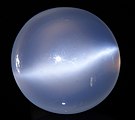Moonstone (gemstone)
| Moonstone | |
|---|---|
 | |
| General | |
| Category | Anorthoclase variety |
| Formula (repeating unit) | (Na,K)AlSi3O8 |
| Crystal system | Monoclinic |
| Identification | |
| Color | Can be numerous colors, including blue, grey, white, pink, peach, green and brown, as well as colorless |
| Cleavage | perfect |
| Fracture | uneven to conchoidal |
| Mohs scale hardness | 6.0 |
| Luster | Opalescent |
| Streak | white |
| Specific gravity | 2.54–2.66 |
| Optical properties | for orthoclase and sanidine, biaxial (–); for oligoclase, biaxial +/– |
| Refractive index | 1.518–1.547 |
| Birefringence | 0.005–0.01 |
| Dispersion | 0.012 |

Moonstone is a sodium potassium aluminium silicate ((Na,K)AlSi3O8) of the feldspar group that displays a pearly and opalescent schiller.[1][2] An alternative name for moonstone is hecatolite[2] (from goddess Hecate).
Etymology
[edit]-
Moonstone polished en cabochon
The name moonstone derives from the stone's characteristic visual effect, called adularescence (or schiller), which produces a milky, bluish interior light. This effect is caused by light diffraction through alternating layers of orthoclase and albite within the stone. The diffracted light varies from white to blue, depending on the thinness of the albite layers.[1] More technically, this micro-structure consists of regular exsolution layers (lamellae) of different alkali feldspars (orthoclase and sodium-rich plagioclase).
Polished moonstones often display chatoyancy ("cat's eye" effect), where a luminous streak appears through the stone. Asterism is rare and produces four-legged stars.[1]
Geology
[edit]
The most common moonstone is of the orthoclase feldspar mineral adularia, named for an early mining site near Mt. Adular in Switzerland, now the town of St. Gotthard.[1][better source needed] A solid solution of the plagioclase feldspar oligoclase +/− the potassium feldspar orthoclase also produces moonstone specimens.
Deposits of moonstone occur in Armenia (mainly from Lake Sevan), Australia, the Austrian Alps, Mexico, Madagascar, Myanmar, Norway, Poland, India, Sri Lanka, and the United States.[2][3] Historically, the most valuable, transparent moonstones with strong blue sheen came from Myanmar.[1] Today, most commercial moonstones come from Sri Lanka.[3]
In culture
[edit]Moonstone has been used in jewellery for millennia, including ancient civilizations. The Romans admired moonstone, as they believed it was derived from solidified rays of the Moon.[4] Both the Romans and Greeks associated moonstone with their lunar deities. In more recent history, moonstone became popular during the Art Nouveau period; French goldsmith René Lalique and many others created a large quantity of jewellery using this stone.[5]
The moonstone is the Florida State Gemstone; it was designated as such in 1970 to commemorate the Moon landings, which took off from Kennedy Space Center. However, it does not naturally occur in the state.[6]
In Thailand, moonstone is known as Mukdahan, the same name as the northeastern province next to the river Mekong, Mukdahan. The name of the province comes from a folklore that a magical gemstone looked like a pearl floating above the Mekong in the area where the province is now located.[7]
See also
[edit]- Belomorite-moonstone
References
[edit]- ^ a b c d e Moonstone Gemological Information International Gem Society, Retrieved 01-05-15
- ^ a b c Moonstone, Mindat.org, retrieved 2022-02-06
- ^ a b "Moonstone" Encyclopædia Britannica, 2011. Web. 20 Jan. 2011.
- ^ "Moonstone" American Gem Trade Association. Retrieved 21 January 2011.
- ^ "Moonstone" International Colored Gemstone Association. Retrieved 26 April 2012.
- ^ "Moonstone – Florida State Symbols". Florida Division of Historical Resource. Retrieved 1 Sep 2011.
- ^ ""มุกดาหาร" เมืองสำราญชายฝั่งโขง" [“Mukdahan” joyfully town on the Mekong coast]. ASTV Manager (in Thai). 2024-11-04. Retrieved 2005-02-16.
External links
[edit] Media related to Moonstone at Wikimedia Commons
Media related to Moonstone at Wikimedia Commons

